Wednesday, 21st February 2024
Daily News Paper Snippets - 21st February 2024

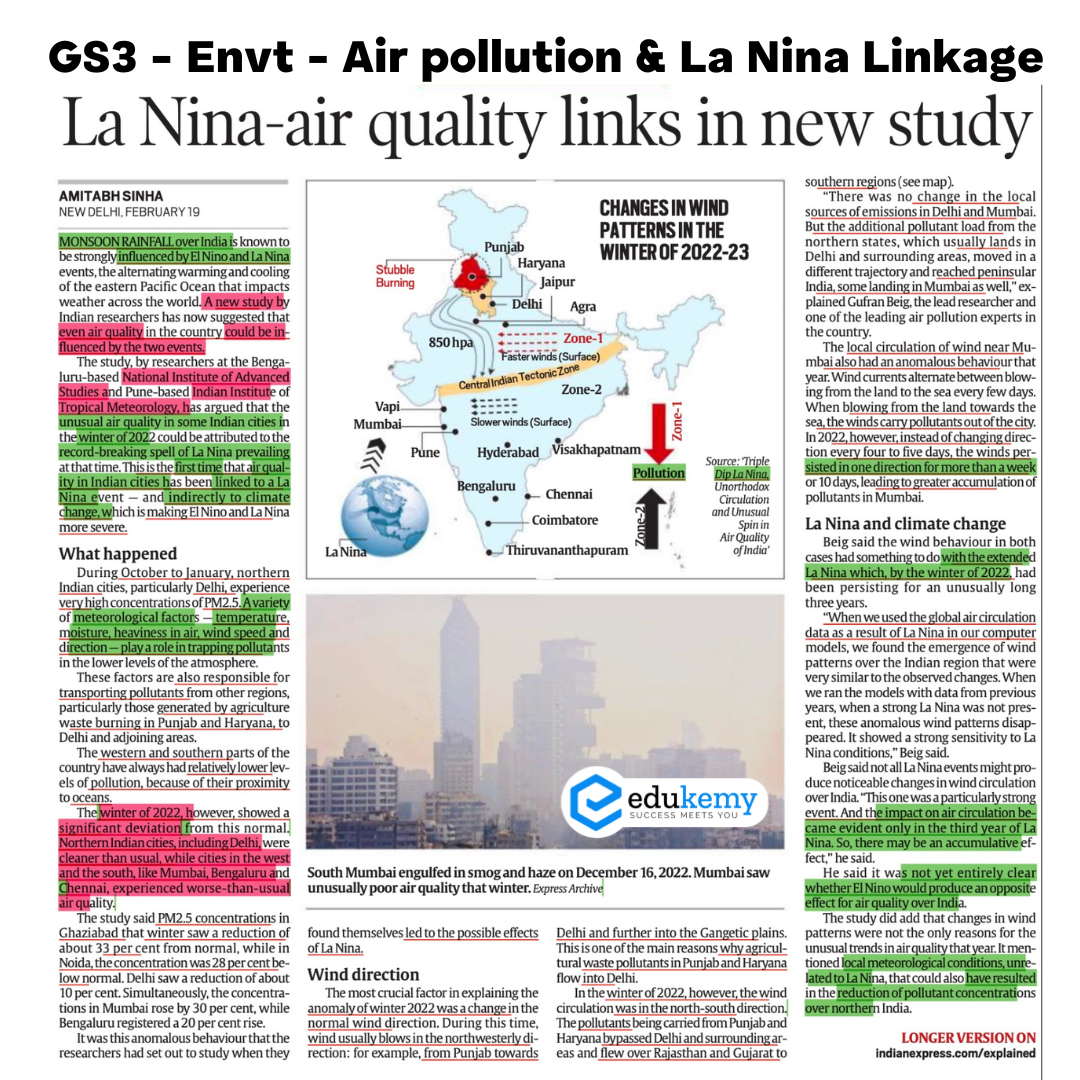
Unlocking Lakshadweep's Potential
In News: Due to its proximity to international shipping routes, Lakshadweep has the potential to emerge as a logistics hub.
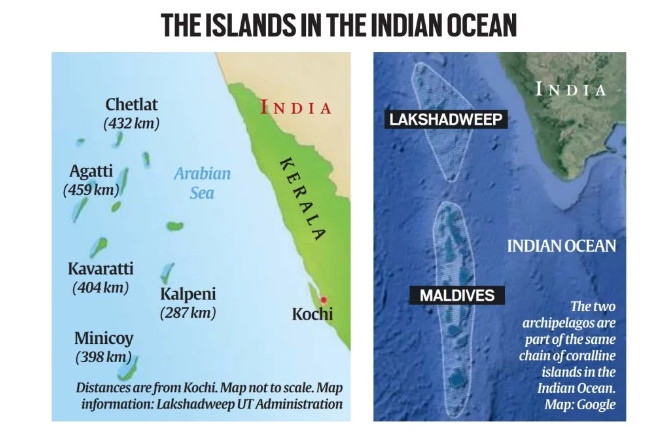
Unlocking Lakshadweep's Potential in Tourism and Logistics
- Tourism Prospects
- Lakshadweep boasts pristine beaches, coral reefs, and clear waters, making it a remarkable tourist destination.
- Proper infrastructure development and sustainable tourism practices could elevate Lakshadweep as a premier hotspot.
- Logistics Opportunities
- Positioned near international shipping routes, Lakshadweep has the potential to become a strategic logistics hub.
- Proximity to coastal Karnataka, especially Mangaluru (a Major Port), opens opportunities for trade partnerships and cargo handling.
- Proposed port connectivity and infrastructure development could streamline trade operations, benefiting local businesses and the regional economy.
- Regional Growth Initiatives
- Development outlined in the Interim Budget 2024-25 benefits Lakshadweep and contributes to regional growth, especially for areas like Mangaluru.
- Budget proposals include projects for port connectivity, tourism infrastructure, and amenities, emphasizing domestic tourism zeal.
- Enhanced connectivity and new cruise routes could boost tourism and economic activities in Lakshadweep and neighboring regions.
- Ecological Significance
- Lakshadweep's restricted designation underscores its ecological importance.
- Suggestions for sustainable practices, like anchoring cruise vessels at sea, aim to protect the delicate ecosystem.
Concerns and Challenges in Lakshadweep's Development
- Environmental Impacts
- Fragile ecosystems, including coral reefs and marine life, are vulnerable to damage from construction, pollution, and increased human activity.
- Mitigating risks requires sustainable development practices and stringent environmental regulations.
- Socio-cultural Considerations
- Rapid development and increased tourism may jeopardize the traditional way of life and cultural heritage of Lakshadweep's indigenous communities.
- Infrastructure Challenges
- Inadequate infrastructure, including transportation, accommodation, and healthcare facilities, poses a significant challenge.
- Balancing modern development while preserving natural beauty requires careful planning and investment.
- Security and Community Engagement
- Lakshadweep's proximity to international shipping routes and its restricted status raise security concerns.
- Coordinated efforts are needed to balance security needs with the promotion of tourism and trade.
- Engaging local communities in planning and implementation is crucial for social cohesion and sustainable development.
Conclusion: Navigating Challenges for Sustainable Development
- Addressing concerns and challenges requires collaboration among government agencies, private sector stakeholders, civil society organizations, and local communities.
- A holistic and inclusive approach to development can help Lakshadweep realize its full potential as a sustainable and thriving island destination.
|
UPSC Previous Year Questions Prelims (2014) Q. Which one of the following pairs of islands is separated from each other by the ‘Ten Degree Channel’? (a) Andaman and Nicobar Ans: (a) Mains (2013) Q. What do you understand by ‘The String of Pearls’? How does it impact India? Briefly outline the steps taken by India to counter this. Mains (2013) Q. Discuss the political developments in the Maldives in the last two years. Should they be of any cause for concern to India? |
Source: TH
Unlocking Lakshadweep's Potential
In News: Due to its proximity to international shipping routes, Lakshadweep has the potential to emerge as a logistics hub.

Unlocking Lakshadweep's Potential in Tourism and Logistics
- Tourism Prospects
- Lakshadweep boasts pristine beaches, coral reefs, and clear waters, making it a remarkable tourist destination.
- Proper infrastructure development and sustainable tourism practices could elevate Lakshadweep as a premier hotspot.
- Logistics Opportunities
- Positioned near international shipping routes, Lakshadweep has the potential to become a strategic logistics hub.
- Proximity to coastal Karnataka, especially Mangaluru (a Major Port), opens opportunities for trade partnerships and cargo handling.
- Proposed port connectivity and infrastructure development could streamline trade operations, benefiting local businesses and the regional economy.
- Regional Growth Initiatives
- Development outlined in the Interim Budget 2024-25 benefits Lakshadweep and contributes to regional growth, especially for areas like Mangaluru.
- Budget proposals include projects for port connectivity, tourism infrastructure, and amenities, emphasizing domestic tourism zeal.
- Enhanced connectivity and new cruise routes could boost tourism and economic activities in Lakshadweep and neighboring regions.
- Ecological Significance
- Lakshadweep's restricted designation underscores its ecological importance.
- Suggestions for sustainable practices, like anchoring cruise vessels at sea, aim to protect the delicate ecosystem.
Concerns and Challenges in Lakshadweep's Development
- Environmental Impacts
- Fragile ecosystems, including coral reefs and marine life, are vulnerable to damage from construction, pollution, and increased human activity.
- Mitigating risks requires sustainable development practices and stringent environmental regulations.
- Socio-cultural Considerations
- Rapid development and increased tourism may jeopardize the traditional way of life and cultural heritage of Lakshadweep's indigenous communities.
- Infrastructure Challenges
- Inadequate infrastructure, including transportation, accommodation, and healthcare facilities, poses a significant challenge.
- Balancing modern development while preserving natural beauty requires careful planning and investment.
- Security and Community Engagement
- Lakshadweep's proximity to international shipping routes and its restricted status raise security concerns.
- Coordinated efforts are needed to balance security needs with the promotion of tourism and trade.
- Engaging local communities in planning and implementation is crucial for social cohesion and sustainable development.
Conclusion: Navigating Challenges for Sustainable Development
- Addressing concerns and challenges requires collaboration among government agencies, private sector stakeholders, civil society organizations, and local communities.
- A holistic and inclusive approach to development can help Lakshadweep realize its full potential as a sustainable and thriving island destination.
|
UPSC Previous Year Questions Prelims (2014) Q. Which one of the following pairs of islands is separated from each other by the ‘Ten Degree Channel’? (a) Andaman and Nicobar Ans: (a) Mains (2013) Q. What do you understand by ‘The String of Pearls’? How does it impact India? Briefly outline the steps taken by India to counter this. Mains (2013) Q. Discuss the political developments in the Maldives in the last two years. Should they be of any cause for concern to India? |
Source: TH
La Nina's Influence on Air Quality in India
In News: A recent study indicates that an extraordinary La Nina event, prolonged by the influence of climate change, initiated an unusual pattern during the winter season of 2022-23 in India.
Normal Climatic Conditions in the Pacific Ocean
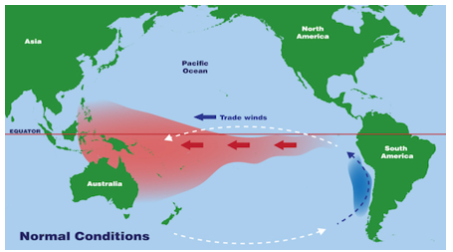
- Near the equator in the Pacific Ocean, the Sun heats the water, creating warm surface conditions.
- Typically, a surface low-pressure system forms in northern Australia and Indonesia, while a high-pressure system develops off the coast of Peru.
- Trade winds blow east to west over the Pacific Ocean, transporting warm surface waters westward.
- This results in convective storms, particularly affecting Indonesia and coastal Australia.
El Nino and La Nina Overview
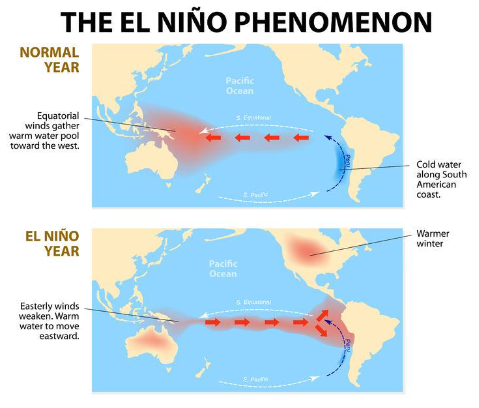
- El Nino and La Nina are opposing climate trends that deviate from normal conditions and occur every two to seven years on average.
- These events, collectively referred to as the El Nino-Southern Oscillation (ENSO) cycle, have global effects on weather, wildfires, ecosystems, and economics.
- El Nino is the warm phase, characterized by warmer water spreading from west to east in the equatorial Pacific Ocean.
- La Nina is the cold phase, marked by cooler water spreading east-west.
Impact of La Nina on Air Quality in India
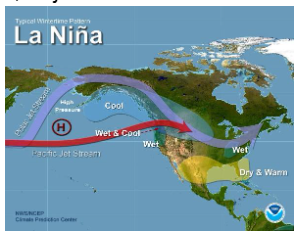
- Study Findings
- Conducted by researchers at the National Institute of Advanced Studies (Bengaluru) and the Indian Institute of Tropical Meteorology (Pune).
- El Nino and La Nina events strongly influence monsoon rainfall in India, impacting weather globally.
- The study reveals the first connection between La Nina and air quality in Indian cities, linked indirectly to climate change.
- Deviation in Winter 2022
- Normally, northern Indian cities, especially Delhi, experience high PM2.5 concentrations during October to January.
- Winter 2022 showed a significant deviation, with Delhi experiencing a 10% reduction, while Mumbai and Bengaluru saw increases of 30% and 20%, respectively.
- The researchers attribute this anomaly to a particularly strong La Nina event.
- Cumulative Effects of La Nina
- Not all La Nina events produce noticeable changes in wind circulation over India, but this strong event impacted air quality.
- The impact on air circulation became evident in the third year of La Nina, suggesting a cumulative effect.
- The study does not yet clarify whether El Nino would produce an opposite effect on air quality over India.
How La Nina Impacted Air Quality in India
- Changing Wind Direction
- In the winter of 2022, wind circulation changed from the typical north-westerly direction to north-south.
- This deviation caused pollutants from Punjab and Haryana to bypass Delhi, flowing over Rajasthan and Gujarat to southern regions.
- Altered Wind Circulation near Mumbai
- Wind currents usually alternate between land-to-sea and sea-to-land directions every few days.
- In 2022, persistent north-south winds for over a week or 10 days led to increased pollutant accumulation in Mumbai.
Source: IE
CMS COP14
In News: The fourteenth session of the Conference of the Parties (CoP) to the Convention on the Conservation of Migratory Species of Wild Animals (CMS 14) has concluded in Samarkand, Uzbekistan.
Key Highlights of CMS COP 14
- Adoption of Listing Proposals
- Parties agreed to adopt listing proposals for 14 migratory species, enhancing protection for species like the Eurasian lynx, Peruvian pelican, and bearded vulture.
- Aimed at strengthening conservation efforts and safeguarding these species.
- Cooperation and Conservation Efforts
- Proposals underscored the importance of cooperation between range states to address threats, conduct research, and implement conservation activities.
- Range states, directly involved in species management, focused on maintaining populations, improving connectivity, safeguarding habitats, and restoring populations.
- Focus on Threats
- Highlighted various threats to migratory species, including habitat degradation, illegal trade, contaminants, and human activities.
- Inclusion in CMS appendices aims to address threats and promote conservation.
- International Collaboration
- Range states collaborated on listing amendments and conservation measures.
- Countries like North Macedonia, Kazakhstan, and others supported joint efforts to protect migratory species.
- Recognition of Endangered Status
- Species like Lahille’s bottlenose dolphin and Peruvian pelican, recognized as 'Vulnerable,' 'Endangered,' or 'Critically Endangered' in IUCN Red List.
- CMS listings aim to improve conservation status and support habitat protection.
- Regional and Global Conservation Initiatives
- Adoption of proposals reflects efforts to address conservation issues regionally and globally.
- Measures recommended for specific populations while considering broader conservation strategies.
Migratory Species Definition
- A species or lower taxon of wild animals that cyclically and predictably cross national jurisdictional boundaries.
- 'Cyclically' refers to recurring cycles, whether astronomical, life-related, or climatic.
- 'Predictably' implies anticipation of recurrence under specific circumstances.
About CMS
- An intergovernmental treaty under UNEP (United Nations Environment Programme), known as the Bonn Convention.
- In force since 1983 with 133 Parties, India being a party since 1983.
- Aims to conserve terrestrial, marine, and avian migratory species globally.
- Two appendices list 'Threatened Migratory Species' (Appendix I) and 'Migratory Species requiring international cooperation' (Appendix II).
India and the CMS
- India signed MoUs with CMS for conservation of Siberian Cranes, Marine Turtles, Dugongs, and Raptors.
- Contributes 8% of global biodiversity with temporary shelter for migratory species.
- Various initiatives, including the National Action Plan for the Conservation of Migratory Birds (2018-2023).
- India's Initiatives for Migratory Species
- Launched various policies and initiatives for the conservation of marine turtles, reduction of pollution, transboundary protected areas, and sustainable infrastructure development.
- Project Snow Leopard (PSL) launched in 2009 for snow leopard conservation.
- Established the first Dugong conservation reserve in Tamil Nadu.
- Wildlife Protection Act, 1972
- Rare and endangered species, including migratory birds, accorded the highest degree of protection under Schedule-I.
- Important habitats notified as protected areas for better conservation.
- Other Initiatives
- Local community involvement in Nagaland for Amur Falcon protection.
- Steps taken to conserve vultures, including the ban on veterinary use of diclofenac.
- Establishment of the Wildlife Crime Control Bureau to control illegal wildlife trade.
Conclusion: India's Commitment to Conservation
- Through various national and international initiatives, India demonstrates a commitment to the conservation of migratory species and their habitats.
- Ongoing efforts align with the goals of CMS and contribute to global biodiversity conservation.
|
UPSC Previous Year Questions Prelims (2014) Q. The most important strategy for the conservation of biodiversity together with traditional human life is the establishment of (a) biosphere reserves Ans: (a) Prelims (2015) Q. With reference to the International Union for Conservation of Nature and Natural Resources (IUCN) and the Convention on International Trade in Endangered Species of Wild Fauna and Flora (CITES), which of the following statements is/are correct?
Select the correct answer using the code given below: (a) 1 only Ans: (b) |
Source: DTE
Forest (Conservation) Act and SC Judgement
In News: The Supreme Court instructed States and Union Territories to follow its 1996 definition of 'forest,' advising against the use of the 2023 amendment to the Forest (Conservation) Act, which allegedly excluded 1.97 lakh square km of land from the forest area.
Lack of Clear Definition of Forest in India
- Absence of Uniform Criteria
- Currently, India lacks a nationally-accepted definition of 'forest.'
- The Forest Advisory Committee (FAC) noted in September 2019 that a uniform criteria applicable to all forest types in all states and union territories is challenging.
- States' Responsibility
- States are tasked with determining their definition of forests.
- The environment ministry emphasized in November 2019 that states, with established forest departments, are better positioned to understand their forests and frame criteria.
- Prerogative of States
- States' authority to define forests is derived from the 1996 Supreme Court order known as the T.N. Godavarman Thirumulpad Vs the UoI.
T.N. Godavarman Thirumulpad Judgment
- Filed in 1995, the petition aimed to protect Nilgiris forest land from deforestation.
- The Supreme Court's 1996 judgement interpreted the term 'forest' broadly, covering all statutorily recognized forests.
Forest Conservation Act 1980
- Enacted to protect India's forests and empower the Central government to regulate forest resource extraction.
- The 2023 Forest (Conservation) Amendment Act highlighted India's commitment to preserving forests and biodiversity.
Forest (Conservation) Amendment Act 2023
- Preamble and Name Change
- Introduced a 'preamble' emphasizing India's commitment to forest preservation.
- The Act's name changed to Van (Sanrakshan Evam Samvardhan) Adhiniyam (Forest Conservation and Augmentation).
- Applicability and Exemptions
- Applies to lands notified as 'forest' after 1980.
- Exemptions include legally diverted forest land, land near international borders for strategic projects, and land for security and defense projects.
- Activities Allowed
- Specifies permissible activities such as establishing check posts, fencing, bridges, running zoos, safaris, and eco-tourism facilities.
Background - Petitions Against Amendments
- Petitions filed challenging the 2023 amendments to the Forest (Conservation) Act.
- Claims of diluting the definition of forest to declared forests and lands recorded as forests after 1980.
Stand of Centre
- The government rejected claims of reducing forest coverage.
- Emphasized the broadened definition of government records.
Forest (Conservation) Act and SC Judgement
- Temporary Order from Supreme Court
- SC issued a temporary order instructing States and Union Territories to follow the 1996 definition of forest.
- Key highlights of the judgement ensuring a broad and encompassing meaning of 'forest.'
- Directions to States
- States directed to file reports on forest land identified as per the T.N. Godavarman case.
- No establishment of zoos or safaris without final approval from the Supreme Court.
Source: TH
TN-SHORE
In News: In the 2024-2025 State Budget, the Tamil Nadu government introduced TN-SHORE, a new initiative aimed at revitalizing coastal resources and safeguarding endangered species.
Key Highlights of TN-SHORE Scheme
- Overview
- TN-SHORE (Neithal Meetchi Iyakkam) is initiated to restore coastal resources in 14 districts, covering 1,076 km, with an estimated cost of Rs 1,675 crore.
- Objectives
- Aimed at enhancing coastal biodiversity, providing coastal protection, improving the livelihoods of coastal communities, and controlling pollution in coastal areas.
- Blue Economy Integration
- Emphasizes the sustainable use of ocean resources for economic growth, job creation, and improved livelihoods, aligning with the concept of the Blue Economy.
- Ecological Focus
- Focuses on the restoration of critical ecosystems like mangroves, coral reefs, and salt marshes, essential for marine health and the coastal economy.
- Sustainable Development Goals (SDGs)
- Aligns with SDG 14 (Life Below Water), contributing to global efforts for the sustainable use and preservation of marine resources.
- Community Engagement
- Involves active participation of local communities, particularly the youth, in the conservation and management of coastal resources.
- Alternative Livelihoods
- Provides coastal communities with alternative livelihood opportunities, including ecotourism, waste management, and circular economy solutions.
- Cultural and Natural Heritage Preservation
- Contributes to the preservation of the cultural and natural heritage of coastal areas, ensuring the sustainable development of these regions.
|
UPSC Previous Year Questions Prelims (2020) Q. What is blue carbon? (a) Carbon captured by oceans and coastal ecosystems Ans: (a) Mains (2018) Q. Defining blue revolution, explain the problems and strategies for pisciculture development in India. |
Source: TH
National Conference on Jal Jeevan Mission and Swachh Bharat Mission- Grameen
In News: The National Conference on Jal Jeevan Mission and Swachh Bharat Mission - Grameen (G) was recently conducted by the Department of Drinking Water and Sanitation in Lucknow, Uttar Pradesh.
Advancing Sustainable Solutions in Rural WASH Sector
- Unified Approach Goal
- Aiming for "A Unified Approach Towards Sustainable Solutions in Rural WASH Sector."
- State Presentations
- State presentations offered valuable insights into regional initiatives and progress, fostering discussions on replicability and sustainability.
- Notable State Experiences
- Kerala's Plastic Waste Management (PWM) initiative was highlighted for effective waste management.
- Tamil Nadu showcased innovative use of plastics in road construction.
- Bihar's innovative "Toilet Clinic" initiative was recognized for its contributions to sanitation.
- WASH Interventions
- Water, Sanitation, and Hygiene (WASH) interventions are strategically designed to deliver life-saving, long-term, and sustainable access to safe water and sanitation.
- Promoting Hygiene Practices
- Emphasizes the promotion of good hygiene practices to reduce the risk of water-related disease transmission.
Source: PIB
Odysseus Spacecraft
In News: Odysseus, the private Nova-C lunar lander by Intuitive Mission, has been launched to the Moon aboard a SpaceX Falcon 9 rocket from NASA's Kennedy Space Center in Florida.

Odysseus Lunar Mission Overview
- Private Lunar Attempt
- Odysseus marks the second private attempt following the Peregrine lander's unsuccessful mission.
- Rocket
- Utilizes SpaceX's Falcon 9, a two-stage rocket designed for Earth's orbit transportation of people and payloads.
- Payloads and CLPS Initiative
- Carries six payloads for NASA as part of the Commercial Lunar Payload Services (CLPS) initiative.
- Aims to test new technologies and scientific instruments during the lunar mission.
- Key Technologies Tested
- LIDAR-based sensor and an electrostatic dust-removal system for spacesuits are among the pivotal technologies being tested.
- Moon Landing Date
- Scheduled to land on the Moon on February 22, 2024.
- Historical Significance
- Aims to achieve the distinction of being the first American spacecraft to land on the Moon in over 50 years since Apollo 17 in 1972.
- NASA Initiatives
- Integral part of NASA's Commercial Lunar Payload Services (CLPS) initiative and the broader Artemis campaign.
Source: TOI
Doctor on Wheels
In News: The Union Minister of Science & Technology recently reported that the "Aarogya-Doctor on Wheels" initiative has delivered medical assistance to approximately 13,000 patients in the remote regions of the Udhampur-Kathua-Doda Lok Sabha constituency.
Doctor on Wheels Initiative Highlights
- AI Technology Integration
- The initiative incorporates AI technology to enhance medical care accessibility.
- Remote Consultations
- Utilizes remote consultations facilitated by specialist doctors, ensuring prompt and comprehensive healthcare services.
- Swift Medical Care
- Aims to deliver medical care within a remarkable timeframe of 45 minutes, emphasizing efficiency.
- Inclusivity Focus
- Prioritizes inclusivity to address healthcare disparities, ensuring that diverse populations have access to quality healthcare.
- Cost-Effectiveness Emphasis
- Addresses the importance of cost-effectiveness, making healthcare services more affordable and accessible.
- Bridging Urban-Rural Divide
- Actively works towards bridging the gap between urban and rural healthcare, contributing to a more equitable distribution of medical services.
Source: PIB
Investor Education Protection Fund (IEPF) and DBS Partnership
In News: In a notable step to boost investor awareness and protection, the Investor Education and Protection Fund Authority (IEPFA) and the Development Bank of Singapore Ltd (DBS) signed a memorandum of understanding (MoU) in New Delhi.
Investor Education Protection Fund (IEPF) and DBS Partnership
- IEPF Establishment
- Inaugurated on September 7, 2016, under the Ministry of Corporate Affairs, Government of India.
- Administrative Role
- Administers the Investor Education Protection Fund (IEPF) with a focus on handling refunds for shares, unclaimed dividends, and matured deposits/debentures, ensuring justice for investors.
- Investor Protection and Awareness
- Aims to promote awareness and safeguard the interests of investors through various initiatives.
- Financial Literacy Programs
- IEPFA has actively organized numerous Investor Awareness Programmes, fostering financial literacy and empowering investors to protect themselves from financial fraud.
- DBS in Asia
- DBS, a prominent financial services group in Asia, operates in 19 markets, serving as a key player in the region's financial landscape.
- DBS Bank India Limited
- DBS Bank India Limited holds the distinction of being the first major foreign bank operating as a wholly-owned, locally incorporated subsidiary in India.
- Comprehensive Banking Services
- Offers comprehensive banking services catering to enterprises and individuals across various scales, contributing to the financial ecosystem in India.
Source: PIB
Quasars
In News: A group of astronomers from around the world has identified J0529-4351 as the brightest and fastest-growing quasar ever found. This quasar is characterized by a supermassive black hole, approximately 17 billion times the mass of the Sun.

Understanding Quasars: A Brief Overview
- Definition
- A quasar is an exceptionally active and luminous form of an active galactic nucleus (AGN).
- AGN refers to a supermassive black hole that is actively feeding at the center of a galaxy.
- Formation
- Quasars are believed to develop in regions of the universe with significantly higher matter density than average.
- They are a subset of AGNs, and not all AGNs are classified as quasars.
- Characteristics
- Quasars rank among the most brilliant, potent, and dynamic celestial entities in the known universe.
- Formation Process
- Active galaxies feature a central supermassive black hole consuming substantial amounts of matter.
- Infalling matter forms a spiraling accretion disk around the black hole.
- High-speed gas clouds in the disk generate heat through friction, reaching temperatures in the millions of degrees.
- Brightness is emitted as a result, and some material is ejected in a luminous, magnetically collimated jet.
- Luminosity
- The nucleus of an active galaxy with a quasar can shine so intensely that it remains observable across vast cosmic distances.
- The brightest quasars can surpass the combined brightness of all stars within their host galaxies.
- Visibility
- Many quasars have been identified billions of light-years away, making them visible at extraordinary distances.
Source: TL
2024: Global Elections Surge Sparks AI Concerns in 83 Countries
In News: In 2024, labeled as the paramount election year by a global magazine, almost half the world's population is set to participate. Amidst traditional challenges, a novel threat in the digital realm, propelled by AI, has surfaced.
Unintended Consequences of Hasty AI Regulations
- Disinformation Surge
- The proliferation of disinformation, exemplified by manipulated videos affecting political figures, poses a significant challenge.
- Example: Manipulated video of Bangladesh Nationalist Party leader Tarique Rahman impacting voter sentiments.
- Meta's delayed response raises questions about content moderation efficacy.
- Reduction in content moderation staff amplifies the challenge, a consequence of 2023 layoffs.
- Pressure to prioritize interventions in influential markets may leave voters in less prominent regions vulnerable.
- Concentration and Ethical Lapses
- AI regulations risk reinforcing industry concentration despite good intentions.
- Requirements like watermarking and red-teaming may favor tech giants, hindering smaller companies.
- Regulations may consolidate power, raising concerns about ethical lapses, biases, and control by dominant entities.
- Navigating Ethical Quagmires
- Developing ethical frameworks introduces challenges, including divergent opinions on priorities.
- Lack of laws mandating AI system audits raises transparency concerns.
- Differing views on AI risks being existential or immediate add complexity.
- Indian context: PM’s Economic Advisory Council members argue risk management is challenging due to AI's non-linear, evolving nature.
Solutions for Policymakers
- Addressing Democracy's Challenges Alongside AI Threat
- Recognize persistent challenges to global democracy, such as unjust imprisonments and electoral disruptions.
- Vote-buying and ballot-stuffing, ingrained in the democratic process, provide a backdrop for AI threats.
- Balancing Urgency with Sensible Regulation
- Caution against hasty AI regulations following the frenzy of 2023.
- Balance addressing AI threats with the potential for unintended consequences and the complexity of regulating a rapidly evolving landscape.
- Planning for Future Challenges
- Advocate for a forward-thinking approach by AI regulators.
- Anticipate and formulate rules that address current risks and proactively tackle future challenges.
- Emphasize the need for a regulatory framework that evolves with the rapid pace of technology.
A Measured Approach for Future-Proof Regulation
- Acknowledge the significance of addressing AI-related electoral risks.
- Caution against hasty regulatory measures and emphasize the importance of foresight.
- Regulators must anticipate future risks to ensure rules remain relevant beyond 2024.
- Advocate for a measured approach to strike a balance between immediate concerns and avoiding unintended consequences in the complex landscape of AI and democracy.
Source: IE
"Solar-Powered Khawa Cluster: Empowering Milk Industry and Skill Development" - Case Study of the Day
"In response to severe droughts, farmers in Osmanabad District have joined a Khawa cluster, diversifying from selling only milk to producing Khoya (reduced dry milk) for increased demand and profitability.
- Organized in cooperatives, farmers pool cattle to make Khawa, yielding higher profits during festivals.
- With 150 cooperatives producing 35,000 kgs daily, the Khawa cluster promotes sustainability with solar-powered machines, curbing deforestation caused by traditional wood-fired kilns.
- The initiative also includes a Skill Development Centre, training over 1,000 youth annually, integrating them into the Khawa value-chain as self-employed individuals."
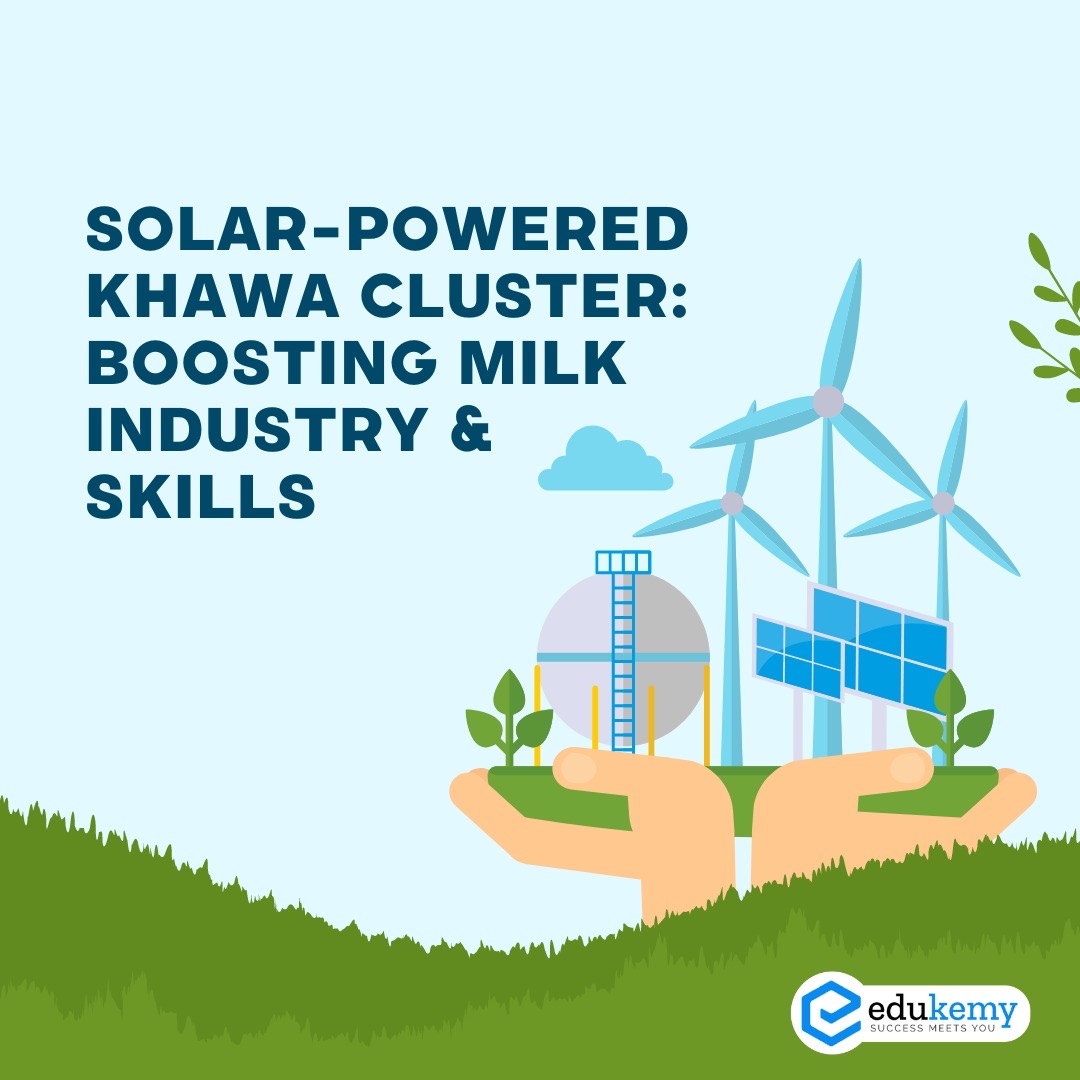
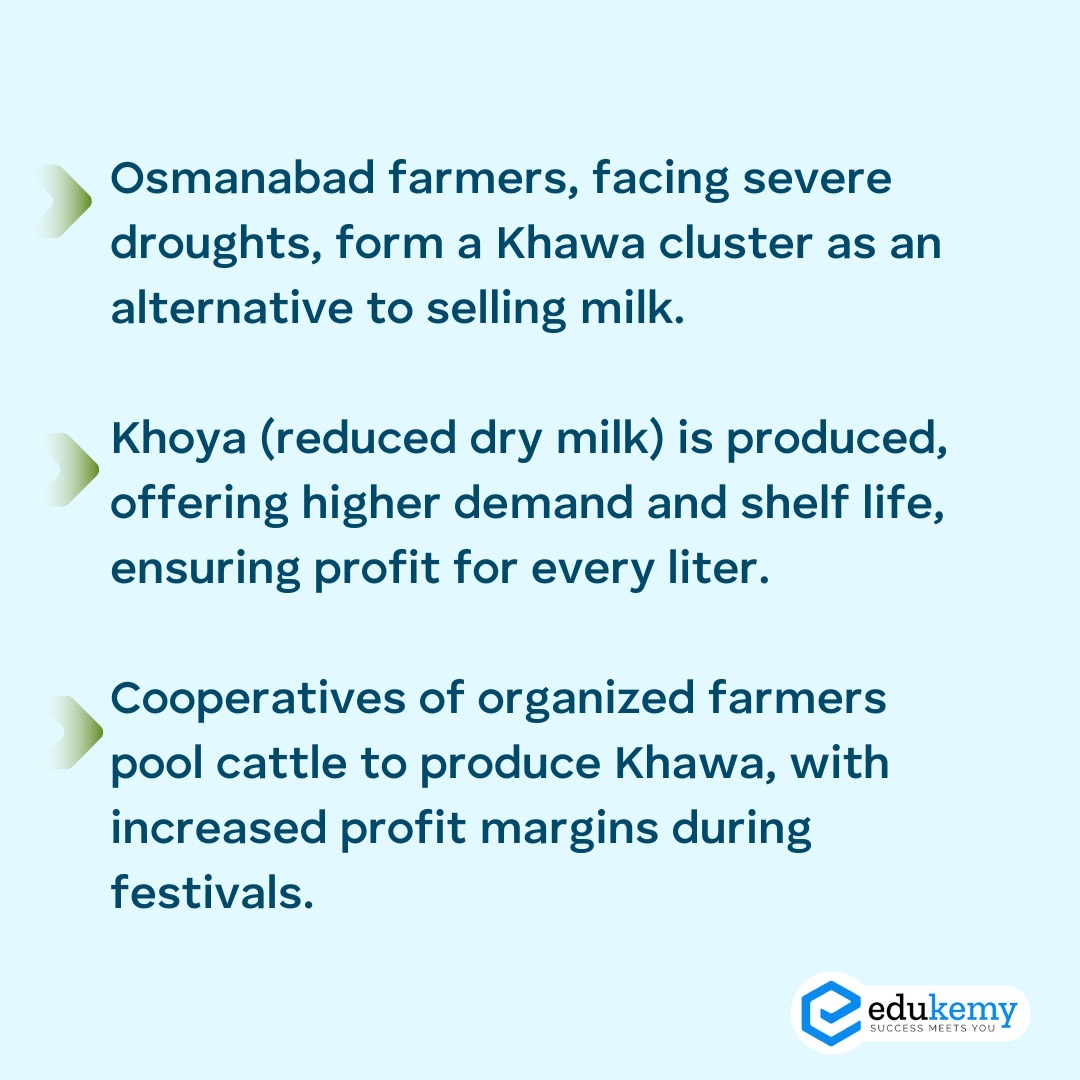
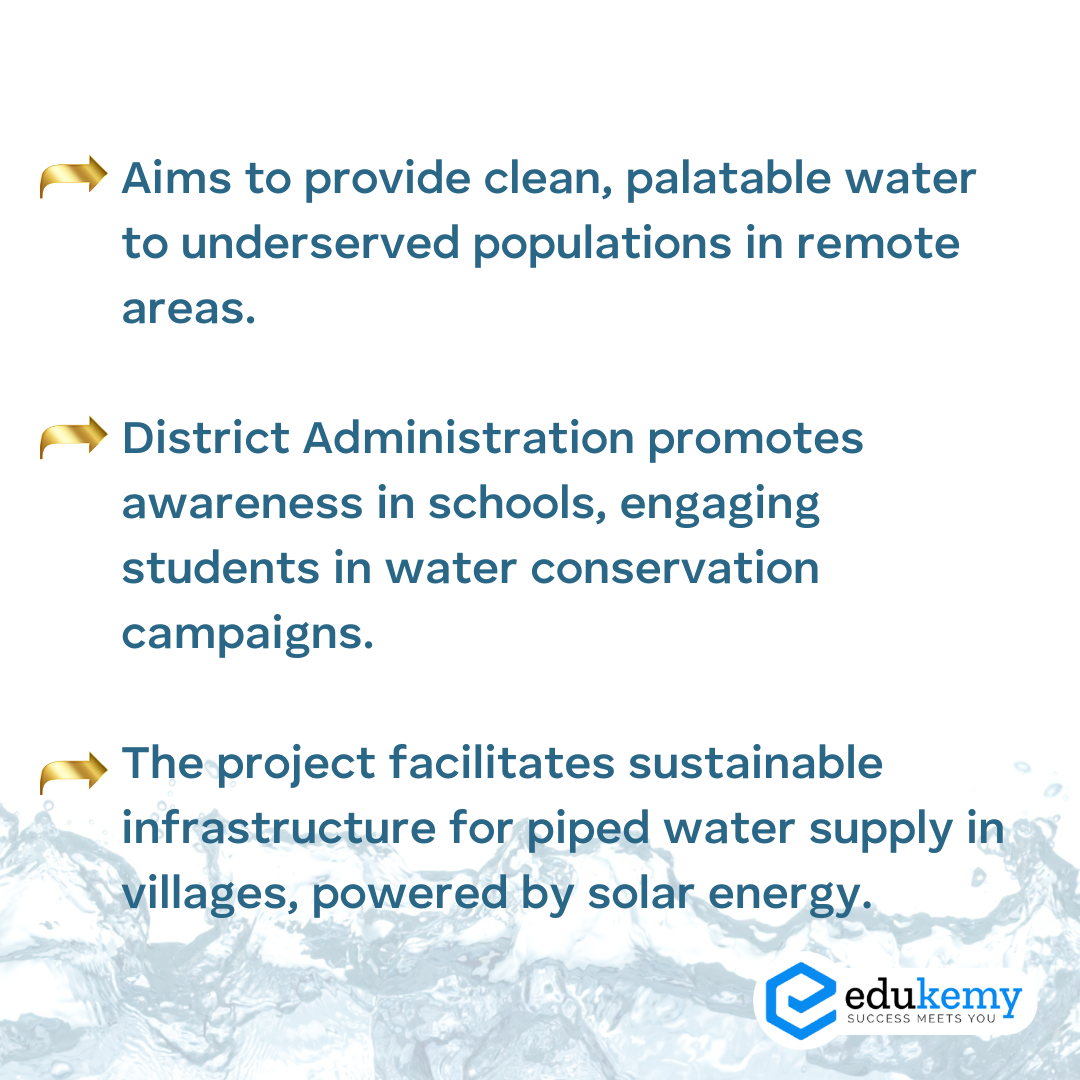
Share the article
Edukemy’s Current Affairs Quiz is published with multiple choice questions for UPSC exams
MCQ
Get Latest Updates on Offers, Event dates, and free Mentorship sessions.

Get in touch with our Expert Academic Counsellors 👋
FAQs
UPSC Daily Current Affairs focuses on learning current events on a daily basis. An aspirant needs to study regular and updated information about current events, news, and relevant topics that are important for UPSC aspirants. It covers national and international affairs, government policies, socio-economic issues, science and technology advancements, and more.
UPSC Daily Current Affairs provides aspirants with a concise and comprehensive overview of the latest happenings and developments across various fields. It helps aspirants stay updated with current affairs and provides them with valuable insights and analysis, which are essential for answering questions in the UPSC examinations. It enhances their knowledge, analytical skills, and ability to connect current affairs with the UPSC syllabus.
UPSC Daily Current Affairs covers a wide range of topics, including politics, economics, science and technology, environment, social issues, governance, international relations, and more. It offers news summaries, in-depth analyses, editorials, opinion pieces, and relevant study materials. It also provides practice questions and quizzes to help aspirants test their understanding of current affairs.
Edukemy's UPSC Daily Current Affairs can be accessed through:
- UPSC Daily Current Affairs can be accessed through Current Affairs tab at the top of the Main Page of Edukemy.
- Edukemy Mobile app: The Daily Current Affairs can also be access through Edukemy Mobile App.
- Social media: Follow Edukemy’s official social media accounts or pages that provide UPSC Daily Current Affairs updates, including Facebook, Twitter, or Telegram channels.






